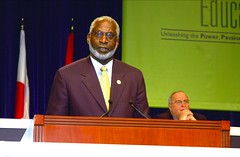Keynoter Satcher Raises Alarm Over Obesity
 There's no question about it. Students are becoming increasingly overweight, and it has reached a point where obesity is as much an educational issue as it is a public health one. So noted former U.S. Surgeon General David Satcher during Saturday's Opening General Session when he addressed "The Obesity Epidemic: What It is Costing Schools."
There's no question about it. Students are becoming increasingly overweight, and it has reached a point where obesity is as much an educational issue as it is a public health one. So noted former U.S. Surgeon General David Satcher during Saturday's Opening General Session when he addressed "The Obesity Epidemic: What It is Costing Schools.""Since 1980, we have seen a doubling of overweight and obesity in children," said Satcher, director, National Center for Primary Care, Morehouse School of Medicine, Atlanta. "In every sense of the word, it is an epidemic if we have ever seen one."
Only two percent of children are eating the recommended servings of fruits and vegetables today, according to Satcher. More than 80 percent of children are eating too much fat, and only one in four American children is getting 30 minutes or more of recommended daily activity.
"The bottom line is that nine million school age children and adolescents are overweight- that's 16 percent of our children," Satcher said. "With obesity, we are facing one of the major threats to health and to learning. That threat to learning is very real."
For example, poorly nourished children score lower on standardized tests, Satcher noted. They are also more irritable, have trouble concentrating and are less able to resist infection.
The former Surgeon General said schools can unwittingly contribute to obesity in children through practices and policies that aggravate poor student health and interfere with their readiness to learn. Students pay the consequences through poorer health and lower academic achievement. School systems pay the consequences through lower state funding, because much of reimbursement is tied to student attendance.
That makes a difference of as much as $28 million a year in New York City schools and $9 million a year in Chicago schools. "Evidence suggests that addressing students' health can help schools meet student performance goals and alleviate financial constraints," Satcher said. "Schools play a critical role in helping students by addressing nutrition and physical activity."
In an effort to address the growing problem of obesity among children, Satcher recommended supporting the Action for Health Kids, which is a partnership of leaders in education, health, industry, parent organizations and government to promote physical activity and nutrition among the nation's children. It involves more than 4,000 volunteers, 51 state teams and 47 national partnership organizations. "You have to motivate students to eat well," Satcher said. "We have an opportunity in our schools and homes to create the kind of environment where children can easily access healthy foods. Action for Healthy Kids is working hard to improve children's eating habits, to increase children's physical activity and to educate administrators, educators, students and others about the importance of these things."
Find out more about ASCD's Health in Education program.


0 Comments:
Post a Comment
<< Home